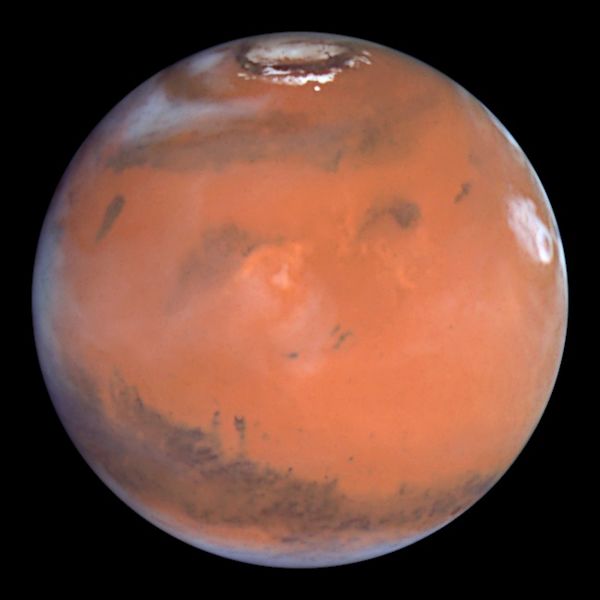Image: Mars and Elysium - GPN-2000-000919

Description: Taking advantage of Mars's closest approach to Earth in eight years, astronomers using NASA's Hubble Space Telescope have taken the space-based observatory's sharpest views yet of the Red Planet. The telescope's Wide Field and Planetary Camera 2 snapped these images between April 27 and May 6, when Mars was 54 million miles (87 million kilometers) from Earth. From this distance the telescope could see Martian features as small as 12 miles (19 kilometers) wide. The telescope obtained these four images, which, together, show the entire planet. Each view depicts the planet as it completes one quarter of its daily rotation. In these views the north polar cap is tilted toward the Earth and is visible prominently at the top of each picture. The images were taken in the middle of the Martian northern summer, when the polar cap had shrunk to its smallest size. During this season the Sun shines continuously on the polar cap. Previous telescopic and spacecraft observations have shown that this summertime "residual" polar cap is composed of water ice, just like Earth's polar caps. These Hubble telescope snapshots reveal that substantial changes in the bright and dark markings on Mars have occurred in the 20 years since the NASA Viking spacecraft missions first mapped the planet. The Martian surface is dynamic and ever changing. Some regions that were dark 20 years ago are now bright red; some areas that were bright red are now dark. Winds move sand and dust from region to region, often in spectacular dust storms. Over long timescales many of the larger bright and dark markings remain stable, but smaller details come and go as they are covered and then uncovered by sand and dust. This image is centered near another volcanic region known as Elysium. This area shows many small, dark markings that have been observed by the Hubble telescope and other spacecraft to change as a result of the movement of sand and dust across the Martian surface. In the upper left of this image, at high northern latitudes, a large chevron-shaped area of water ice clouds mark a storm front. Along the right limb, a large cloud system has formed around the Olympus Mons volcano.
Title: Mars and Elysium - GPN-2000-000919
Credit: Great Images in NASA Description
Author: NASA, Steve Lee University of Colorado, Jim Bell Cornell University,
Permission: This file is in the public domain in the United States because it was solely created by NASA. NASA copyright policy states that "NASA material is not protected by copyright unless noted". (See Template:PD-USGov, NASA copyright policy page or JPL Image Use Policy.) Warnings: Use of NASA logos, insignia and emblems is restricted per U.S. law 14 CFR 1221. The NASA website hosts a large number of images from the Soviet/Russian space agency, and other non-American space agencies. These are not necessarily in the public domain. Materials based on Hubble Space Telescope data may be copyrighted if they are not explicitly produced by the STScI.[1] See also Template:PD-Hubble and Template:Cc-Hubble. The SOHO (ESA & NASA) joint project implies that all materials created by its probe are copyrighted and require permission for commercial non-educational use. [2] Images featured on the Astronomy Picture of the Day (APOD) web site may be copyrighted. [3] The National Space Science Data Center (NSSDC) site has been known to host copyrighted content even though its photo gallery FAQ states that all of the images in the photo gallery are in the public domain.
Usage Terms: Public domain
License: Public domain
Attribution Required?: No
Image usage
The following page links to this image:

